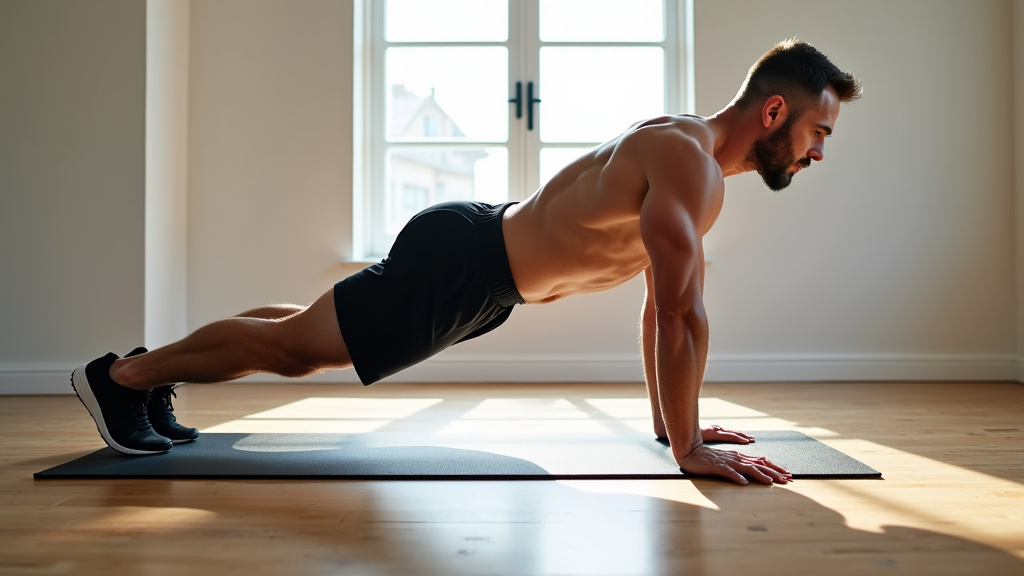Want a stronger, more defined core? The stomach vacuum workout is a proven exercise helping men achieve impressive results in their fitness journey. This powerful technique targets the transverse abdominis – your body’s natural corset muscle – to create a stronger, more stable core and a trimmer waistline.
Unlike traditional crunches or sit-ups that focus on surface muscles, the stomach vacuum exercise works deep within your core. By drawing your belly button toward your spine, you engage muscles that most workouts can’t reach. Bodybuilders have long used this exercise to create that coveted V-taper physique, but its benefits extend far beyond aesthetics.
The exercise stands out for its versatility and accessibility. Whether you’re a busy professional or a dedicated gym-goer, you can perform stomach vacuums anywhere – at home, at work, or during your regular workout routine. As noted in a Medical News Today article, this exercise strengthens your core while improving posture and reducing back pain.
This guide shows you how to perform the stomach vacuum workout effectively, details its benefits for men’s fitness, and explains techniques to maximize your results. Whether you’re beginning your fitness journey or advancing your core training, this exercise could be the key component missing from your workout routine.
Understanding the Stomach Vacuum Exercise

The stomach vacuum exercise is a fascinating technique that targets the deepest layer of your abdominal muscles – the transverse abdominis. This muscle acts as your body’s natural corset, wrapping horizontally around your midsection to support your spine and internal organs.
Unlike traditional crunches or sit-ups that build visible abs, this isometric exercise focuses on strengthening your core from the inside out. When performing a stomach vacuum, you create a powerful internal lift by drawing your navel toward your spine while exhaling, similar to your natural reaction when stepping into cold water.
According to a 2019 research study, this exercise is particularly effective at activating the transverse abdominis compared to other core stabilization techniques. The study found it helps reduce spine loading that often leads to injury and pain.
What makes the stomach vacuum truly unique is its versatility – you can practice it while standing in line at the grocery store, sitting at your desk, or even lying in bed. It serves as a portable gym for your deepest core muscles, accessible whenever you have a moment to practice.
Beyond core strength, this exercise plays a crucial role in improving posture and spinal stability. A strong transverse abdominis functions as a supportive belt around your midsection, helping maintain proper alignment throughout daily activities and potentially reducing the risk of back pain.
While some people turn to this exercise hoping for a flatter stomach, its real value lies in the functional strength it builds. Just as a house needs a solid foundation before decorative features can be added, your core needs this deep structural support before focusing on surface-level aesthetics.
Benefits of Stomach Vacuums for Men
Stomach vacuums pack a powerful punch when it comes to core development. This deceptively simple exercise, made famous by bodybuilding legend Arnold Schwarzenegger, targets the transversus abdominis – your body’s natural weight belt that wraps around your midsection.
One of the most significant advantages for men is the dramatic improvement in core strength. By engaging the deepest layer of abdominal muscles, stomach vacuums provide stability that basic crunches simply can’t match. This enhanced core activation creates a solid foundation for better spine support and overall stability.
Posture improvement is crucial, particularly for desk-bound individuals. Regular practice of stomach vacuums trains your core muscles to better support your spine, naturally pulling your shoulders back and lifting your chest. You’ll find yourself standing taller and moving with more confidence.
Enhanced Athletic Performance
Whether you’re hitting the gym or playing recreational sports, stomach vacuums can give you a competitive edge. This exercise strengthens your core’s ability to stabilize during dynamic movements, which translates to better power transfer in everything from deadlifts to golf swings.
The transverse abdominis activation achieved through stomach vacuums helps protect your spine during heavy lifts. This means you can push harder in your workouts while maintaining better form and reducing injury risk.
For athletes engaged in contact sports, the increased core stability provides better protection against impacts and improves rotational power for movements like throwing or striking.
Aesthetic and Health Benefits
Let’s be honest – many men are interested in achieving that coveted V-taper physique. Stomach vacuums can help create a more defined midsection by training those deep core muscles to stay naturally contracted, giving you better waist control.
Beyond the visual benefits, this exercise supports crucial aspects of men’s health. The engagement of deep core muscles helps maintain healthy posture during long workdays, potentially reducing the risk of back pain and discomfort.
The practice also promotes better breathing patterns and aids digestion through muscular contractions that massage your internal organs in a unique way.
Functional Fitness Improvements
Stomach vacuums excel in everyday functionality. The strengthened core translates to better stability in daily activities, from lifting groceries to playing with your kids.
The exercise helps develop greater mind-muscle connection, making it easier to engage your core during other workouts or daily tasks. This improved awareness enhances overall movement quality and efficiency.
Perhaps most importantly for long-term health, regular practice can help maintain core strength as you age, supporting better balance and reducing the risk of falls or injuries later in life.
Proper Technique for Stomach Vacuums

Mastering the stomach vacuum requires precise technique and mindful execution. As someone who’s guided countless clients through this powerful core exercise, I’ve seen firsthand how proper form can transform its effectiveness.
Let’s break down this advanced core-strengthening technique into manageable steps to help you progress from beginner to advanced levels. Remember, patience and consistency are key to mastering this exercise.
Getting Started: Basic Position and Breathing
Begin by selecting your preferred position – either lying on your back, standing straight, or on all fours. For beginners, I recommend starting in a supine position (lying down) as it provides better control and awareness of your core muscles.
The foundation of an effective stomach vacuum lies in proper breathing. Take a deep breath through your nose, filling your lungs completely. As you exhale slowly through your mouth, focus on drawing your navel toward your spine.
Many practitioners make the mistake of simply sucking in their stomach rather than engaging their deep core muscles. The key difference lies in the intention – you’re aiming to activate your transverse abdominis, the deep core muscle that acts like a natural corset.
Executing the Perfect Vacuum
Once you’ve mastered the breathing pattern, focus on the vacuum movement. As you exhale fully through pursed lips, consciously contract your abdominal muscles, pulling them inward toward your spine. This should feel like a deep, internal lift rather than a superficial sucking in.
According to research from Healthline, maintaining proper form during this phase is crucial for targeting the transverse abdominis effectively. Create space between your belly button and spine while keeping your shoulders relaxed.
A common error I see is holding the breath during the contraction. Instead, maintain shallow, controlled breathing while holding the vacuum. This helps sustain the exercise longer and prevents unnecessary tension.
Progression and Advanced Techniques
Start with holding the vacuum for 10-15 seconds, gradually working up to 30-second holds as your strength improves. Beginners should aim for 2-3 sets, while advanced practitioners can perform up to 5 sets per session.
As you become more comfortable with the basic technique, try performing the vacuum in different positions – standing, seated, or on all fours. Each position challenges your core uniquely and helps develop comprehensive strength.
Listen to your body’s signals and avoid overexertion. If you feel dizzy or experience back pain, take a break and reassess your form. The goal is progressive improvement, not immediate perfection.
| Position | Difficulty Level | Description | Benefits |
|---|---|---|---|
| Supine (Lying Down) | Easy | Lay on your back with your knees bent and feet flat. Draw your navel towards your spine. | Better control and awareness of muscles |
| Standing | Moderate | Stand straight with feet hip-width apart. Engage core by pulling belly button towards spine. | Improves posture and core stability |
| Kneeling (Quadruped) | Hard | Start on all fours, ensuring back is flat and neutral. Engage core by pulling belly towards spine. | Challenges stability and core engagement |
| Sitting | Hard | Sit upright with back straight. Engage core by pulling belly button towards spine. | Involves stabilizing muscles, improves posture |
| Prone (Face Down) | Very Hard | Lay face down with arms extended past head. Engage core by pulling belly towards spine. | Most challenging, enhances deep core strength |
Incorporating Stomach Vacuums into Your Workout Routine
Building a strong core doesn’t always require fancy equipment or complicated routines. Stomach vacuums offer an effective way to strengthen your deep abdominal muscles, and incorporating them into your existing workout regimen is straightforward.
Whether you’re a seasoned athlete or just beginning your fitness journey, mastering stomach vacuums can transform your core training approach. Let’s explore how to make this exercise a regular part of your routine.
Optimal Timing and Frequency
For best results, perform stomach vacuums 3-4 times per week, allowing your transverse abdominis adequate recovery time between sessions. Fitness experts recommend practicing them first thing in the morning on an empty stomach when your abdominal muscles are most responsive.
Start with 2-3 sets of 20-second holds and gradually increase duration. As noted in research on vacuum training, consistency is crucial for improving core strength and stability.
The exercise is particularly effective during regular core training sessions, though you can perform it throughout the day.
Progressive Duration Building
Like any exercise, stomach vacuums require systematic progression. Begin with shorter holds of 10-15 seconds if you’re new to the movement, focusing on proper form and breathing technique.
As your strength improves, gradually increase the duration of each hold. By week three, aim to maintain the vacuum for 45-60 seconds per set, performing 3-5 sets per session.
Remember to maintain steady, shallow breathing throughout each hold – this isn’t about holding your breath, but about maintaining control of your deep core muscles.
Combining with Other Core Exercises
Stomach vacuums integrate well into a comprehensive core routine. Incorporate them between sets of traditional ab exercises to maximize effectiveness.
For instance, perform a set of stomach vacuums after planks or during rest periods between crunches. This approach maintains constant core engagement throughout your workout.
The vacuum can also enhance other exercises – try engaging it while performing planks or during the eccentric phase of sit-ups for an added challenge to your core stability.
Daily Integration Opportunities
A key advantage of stomach vacuums is their practicality – you can perform them virtually anywhere, at any time. Practice them while sitting at your desk, standing in line, or during your morning commute.
These “stealth” training sessions reinforce proper core engagement and improve your mind-muscle connection throughout the day. Maintain proper form, even during casual practice sessions.
Don’t limit yourself to structured workout times – the more you practice the vacuum, the more natural it becomes, leading to better overall core control and posture.
Variations and Progressions for Advanced Practitioners

Once you’ve mastered the foundational stomach vacuum technique, you’re ready to explore more challenging variations to elevate your core strength. Advanced practitioners will benefit from these progressive modifications that target the transverse abdominis and surrounding core muscles.
Advanced Positional Variations
Moving beyond basic standing and lying positions, you can perform stomach vacuums in more challenging stances. The quadruped (all-fours) position creates a stability challenge as you work against gravity to draw your navel toward your spine.
A particularly demanding variation involves performing the vacuum while holding a plank position. This combines the core-strengthening benefits of both exercises while requiring precise muscle control and endurance to maintain proper form.
For those seeking an extra challenge, try performing vacuums in a prone position (face down) with your arms extended overhead. This variation intensifies muscle activation and control through unique gravitational forces.
Adding Resistance for Greater Challenge
To intensify the exercise, incorporate external resistance using medicine balls or light dumbbells. Place the weight on your lower back during the quadruped vacuum to create additional resistance for your core muscles.
Another effective progression combines stomach vacuums with dynamic movements like lunges or squats. This challenges your ability to maintain the vacuum during compound exercises, substantially increasing the difficulty level.
Remember to maintain proper breathing throughout these advanced variations – if you find yourself holding your breath, return to basic progressions until you develop better control.
Dynamic Movement Integration
For the most advanced practitioners, incorporate stomach vacuums into flowing movement patterns. This includes transitioning between yoga poses while maintaining the vacuum or performing the exercise during controlled martial arts movements.
Movement-based progressions require exceptional core control and body awareness. Begin with simple transitions and gradually progress to more complex movement patterns as your strength and control improve.
Always prioritize quality over quantity when attempting these advanced variations. Master the basic vacuum technique before progressing to more challenging versions.
Combining Stomach Vacuums with Other Core Exercises
Stomach vacuums are most effective when paired strategically with complementary core exercises. By combining this powerful technique with other movements, you’ll create a comprehensive routine that targets every layer of your abdominal muscles.
The transverse abdominis, activated through stomach vacuums, works like a natural corset for your core. According to Medical News Today, this deep muscle plays a crucial role in spine stabilization and injury prevention.
Essential Exercise Pairings
Start your core workout with stomach vacuums to activate those deep abdominal muscles. This primes your core for the exercises that follow, enhancing their effectiveness and ensuring proper form.
Planks pair exceptionally well with stomach vacuums, as they reinforce the same stabilizing muscles. Hold a plank immediately after your vacuum set to maximize engagement.
Russian twists complement stomach vacuums by adding rotational movement to your routine. This combination strengthens both your deep core muscles and obliques, developing comprehensive abdominal strength.
Creating Your Routine
Begin with three sets of stomach vacuums, holding each for 15-30 seconds. Take brief rest periods between sets to maintain proper form and breathing.
Follow with two rounds of planks, holding each for 45-60 seconds. Maintain the same drawn-in feeling you achieved during the vacuums.
Complete your workout with three sets of leg raises, targeting your lower abs while maintaining that vacuum-activated core. This ensures a balanced approach to abdominal training.
Advanced Combinations
Once you’ve mastered the basics, incorporate stomach vacuums during other exercises. This advanced technique enhances the effectiveness of both movements.
Mountain climbers with vacuum holds create an intense core challenge. The dynamic lower body movement tests your ability to maintain deep core engagement.
Side planks combined with vacuum holds target your obliques while maintaining deep core activation. This combination particularly benefits athletes requiring rotational power and stability.
Maximizing Results: Diet and Lifestyle Factors

Your stomach vacuum exercise routine is only part of the equation for achieving visible core results. Success comes from combining these exercises with strategic lifestyle modifications that support your goals.
A well-structured approach to nutrition plays a pivotal role in revealing those hard-earned abs. Research indicates that maintaining proper caloric balance is essential for fat loss, which directly impacts the visibility of your abdominal muscles.
Consider your body a finely-tuned machine that requires premium fuel to perform optimally. Loading up on lean proteins, fresh vegetables, and whole grains provides the essential building blocks for muscle development and recovery.
Sleep Quality: Your Secret Weapon
Quality sleep is just as crucial as your workout routine. Poor sleep can sabotage your efforts by disrupting hormonal balance and increasing cortisol levels, leading to stubborn belly fat.
Creating a consistent bedtime routine helps regulate your body’s natural sleep-wake cycle. Try dimming the lights an hour before bed and keeping your bedroom cool and dark for optimal rest.
Set yourself up for success by aiming for 7-8 hours of uninterrupted sleep each night. Your body performs vital repair and recovery work during these hours of rest.
Stress Management for Core Development
Chronic stress can derail your fitness goals. When stress levels spike, your body produces excess cortisol, which can lead to increased fat storage around your midsection.
Incorporate stress-reducing activities like deep breathing exercises or meditation into your daily routine. Just 10 minutes of mindful practice can make a significant difference in managing stress levels.
Remember that progress isn’t linear – some days will be better than others. Listen to your body and adjust your routine as needed, whether that means taking an extra rest day or modifying your workout intensity.
Lifestyle Habits That Support Your Goals
Small daily choices create significant results over time. Stay hydrated by drinking water throughout the day to reduce bloating and support muscle function.
Track your meals and stress levels in a journal to identify patterns affecting your progress. This awareness enables better decisions about your health.
Remember that sustainable results come from consistent, healthy habits rather than extreme measures. Focus on building lifestyle changes you can maintain long-term.
Conclusion: Elevating Your Core Strength with Stomach Vacuums
The stomach vacuum stands as one of the most effective yet underutilized exercises for developing exceptional core strength. Research from the Journal of Orthopaedic & Sports Physical Therapy confirms this ancient technique’s remarkable benefits for strengthening the transverse abdominis and enhancing overall core stability.
What sets stomach vacuums apart is their versatility and accessibility. You don’t need expensive equipment or a gym membership – just dedication to proper form and consistent practice. The exercise’s ability to strengthen deep core muscles while improving posture makes it an invaluable addition to any fitness routine.
The transformative effects of stomach vacuums extend beyond core strength alone. Regular practice leads to improved spinal stability, enhanced breathing control, and a more defined midsection – benefits that enhance both athletic performance and daily activities. Your transverse abdominis acts as nature’s weight belt, providing crucial support for every movement you make.
As you incorporate stomach vacuums into your routine, remember that mastery comes through patience and persistence. Focus on maintaining proper technique, gradually increasing hold times, and staying consistent with your practice. Your dedication will yield improved core strength, better posture, and enhanced overall fitness that you’ll feel in every movement.
The path to a stronger core lies before you, and stomach vacuums serve as an effective tool for achieving your goals. This time-tested practice offers a practical solution for building foundational strength that benefits every aspect of your active life.







